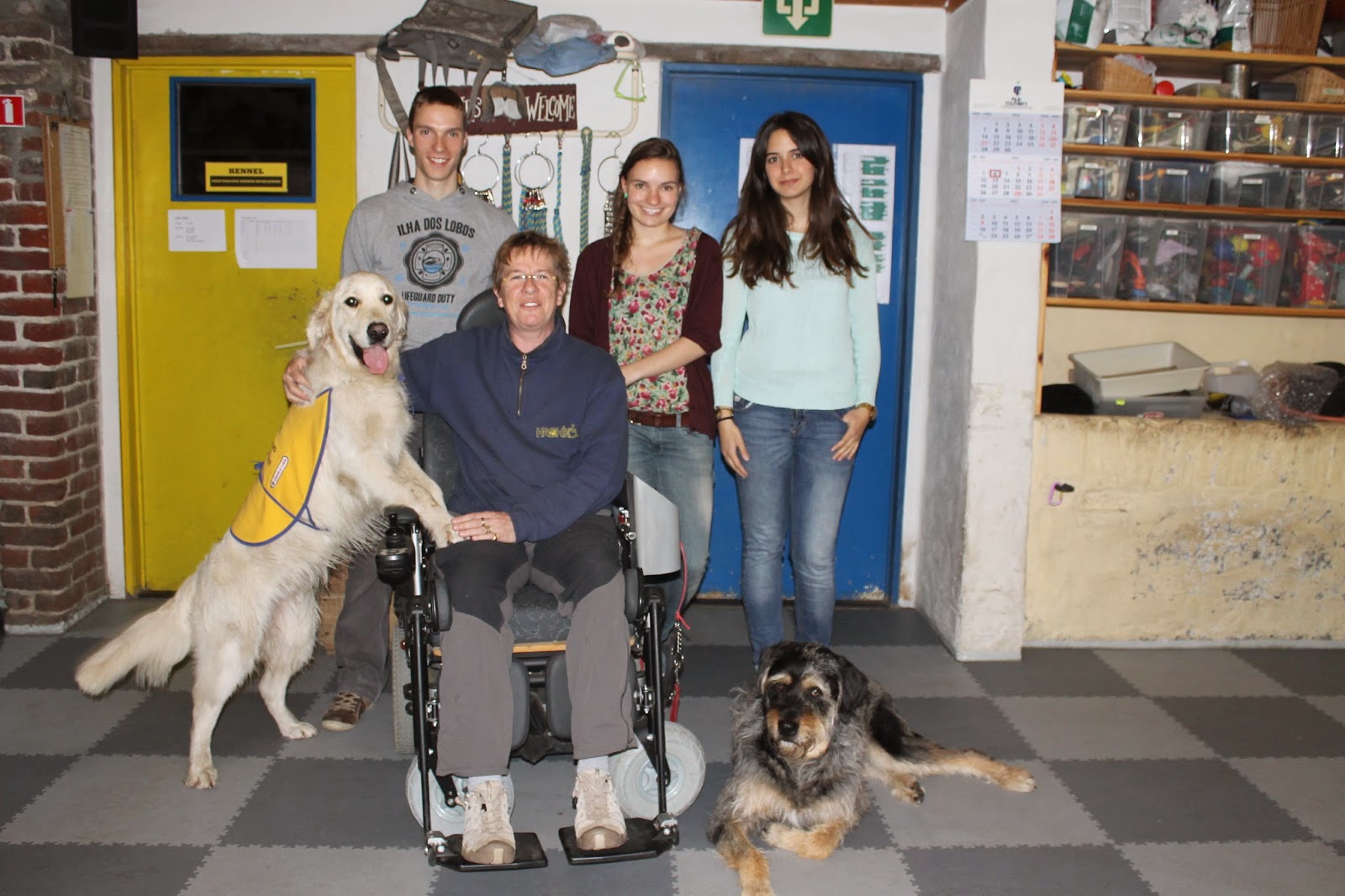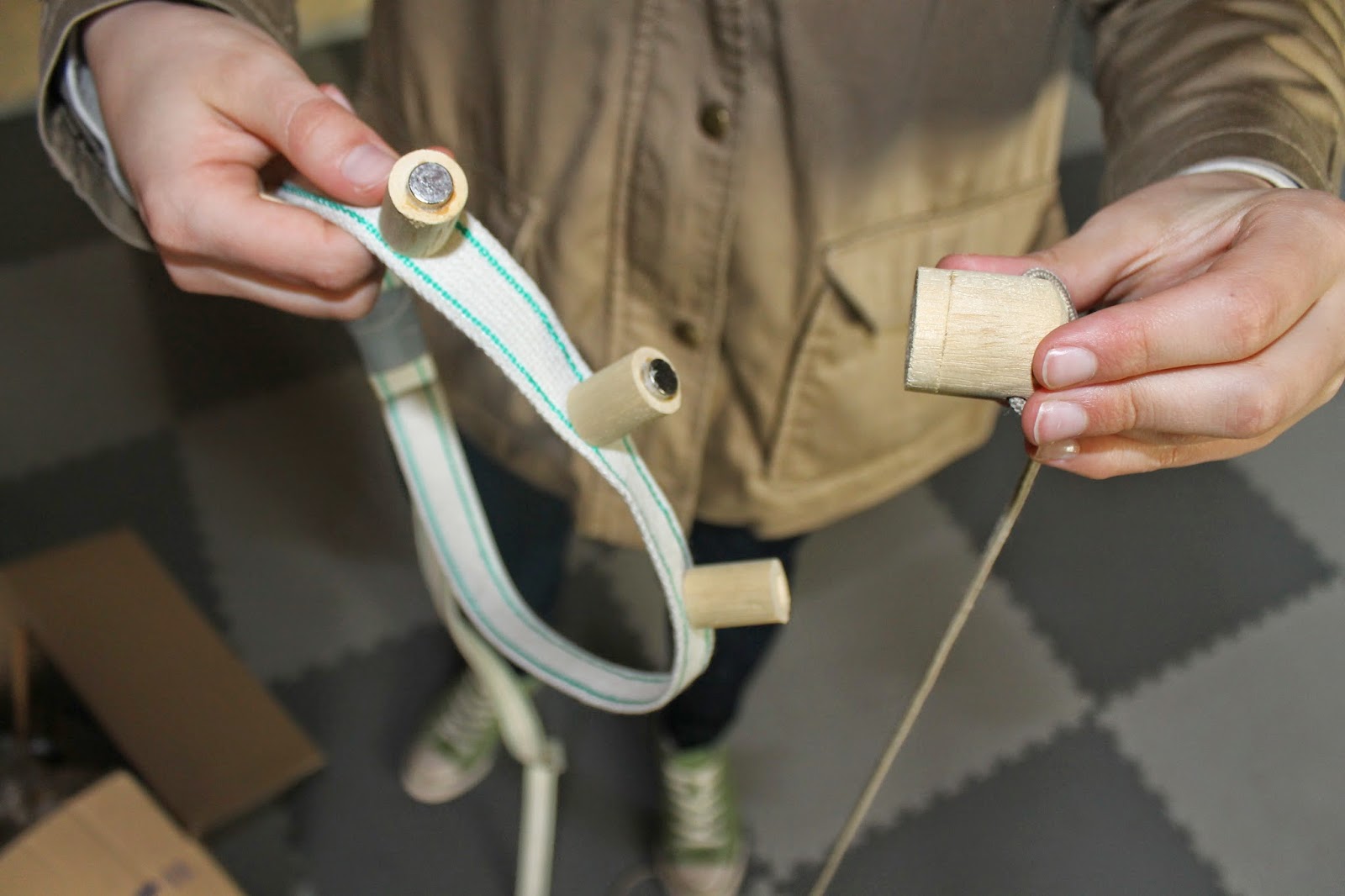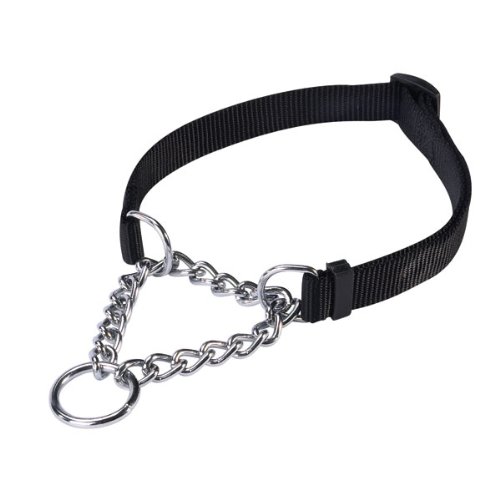Below you can find the link to the instructable, in which is shown how the product is produced:
donderdag 5 juni 2014
zondag 18 mei 2014
dinsdag 13 mei 2014
maandag 12 mei 2014
zondag 11 mei 2014
Prototype 48
EXPLANATION //
Evolution of prototype 47
Based on the testing in prototype 47, we adapted our design:
VISUALIZATION //
EVALUATION //
Evolution of prototype 47
Based on the testing in prototype 47, we adapted our design:
- use of double-slip collar
- leash is braided directly on the collar: lighter connection
- rope that holds the golfabll is sewed on the collar: stronger that knot
VISUALIZATION //
all parts needed to make this prototype:
EVALUATION //
Prototype 47
EXPLANATION //
Testing of prototype 46
VISUALIZATION //
EVALUATION //
Testing of prototype 46
VISUALIZATION //
the dog tries to put the collar on, but sometimes he tries to escape again
this leash is directly fixed to a buckle.
It is especially made for hachiko.
We use this braiding technique as an inspiration for the fixation of our leash to our collar
in our next prototype.
EVALUATION //
conclusions:
as an extra remark, we want to add that the connection between the collar and the leash, has to be as light as possible, because otherwise, the weigth prevents that the collar falls open well. So the result is that the dog can't put his head through the collar.
We will use the double-slip collar and braid a leash directly on it.
zaterdag 10 mei 2014
Prototype 46
EXPLANATION //
Adapting prototype 45.
VISUALIZATION //

EVALUATION //
Adapting prototype 45.
- We bought a choke collar, because of the instructable: it is a standard piece.
- We tried to position the rope with the ball a little bit further from the ring, so that the rope wouldn't twist around the collar.
- We tried different material to make this little rope more stif: a thick elastic, a thick rope, foam around a rope, a straw around the rope, and an electricity cable. The straw around the rope was the best solution, but it wasn't durable. So be bought a small transparant PVC tube that fulfills the same function.
VISUALIZATION //
For the fixation to the wheelchair, we use the bar under the armseat.
We prototype a metal bar with two 90° angles in it (so that the box doensn't stick out of the wheelchair)
The PVC box is attached to it with help of 2 bolts.

All materials needed for this prototype
EVALUATION //
zondag 4 mei 2014
Wheelchair dimensions
Explanation//
Fixation prototype 44
To fix our final prototype to the wheelchair, we have to design a good fixation system. Till now, we used simple zip-ties (see prototype 44) to fasten it to the chair.
We made a sketch with the relevant dimensions of the chair in order to design the right fixation system.
There's enough space at the end of the left arm to place the final prototype.
Fixation prototype 44
To fix our final prototype to the wheelchair, we have to design a good fixation system. Till now, we used simple zip-ties (see prototype 44) to fasten it to the chair.
We made a sketch with the relevant dimensions of the chair in order to design the right fixation system.
There's enough space at the end of the left arm to place the final prototype.
vrijdag 2 mei 2014
prototype 45
EXPLANATION //
testing of prototype 44
VISUALIZATION //
EVALUATION //
testing of prototype 44
VISUALIZATION //
searching the ball and throwing him in the box without clicker)
'knee-command' => ball out of box
dog can dettach himself without help
the ball jumps out of the box
EVALUATION //
extra: Caroline told us that maybe the prototype will work only one time if the dog has made a kind of knot by dropping the ball in the wrong way, untill someone untangles the two ropes again. But if it can work once, then that would be already a great help for some people. And the owner of the dog can guide his dog more, and train him to make less mistakes. If the dog does everything in the right way, the prototype can be used several times.
sequence of operations the dog has to do:
((1) ready to go: putting head through loop - (2) jump up - (3) walking to store etc - (4) home again: take ball - (5) drop it in box - get head out of the loop - free to walk alone)
if the dog made a mistake in step 4 or 5 , he will nog be able put the collar on for another trip.
donderdag 1 mei 2014
prototype 44
EXPLANATION //
Improvement of prototype 34 after testing it at visit of 17/04.
We made a cylindrical 'box' with a slot. We cut it diagonally, so no matter where the dog
throws the ball in, it will always end up in the slot.
We also fixed the end of the leash, not on the box, but elsewhere on the wheelchair.
(Note: this end has to be higher then the slot, because otherwise the ball will maybe jump
out of the box). We also reinforced the red rope that leads to the golf ball, so that it would twist less around the leash. The box is temporary fixed to the wheelchair with cable ties.
VISUALIZATION //
EVALUATION //
Improvement of prototype 34 after testing it at visit of 17/04.
We made a cylindrical 'box' with a slot. We cut it diagonally, so no matter where the dog
throws the ball in, it will always end up in the slot.
We also fixed the end of the leash, not on the box, but elsewhere on the wheelchair.
(Note: this end has to be higher then the slot, because otherwise the ball will maybe jump
out of the box). We also reinforced the red rope that leads to the golf ball, so that it would twist less around the leash. The box is temporary fixed to the wheelchair with cable ties.
VISUALIZATION //
EVALUATION //
prototype 43
EXPLANATION //
testing of prototype 41
VISUALIZATION //
EVALUATION //
testing of prototype 41
VISUALIZATION //
failed attempt
successful attempt
EVALUATION //
dinsdag 29 april 2014
Prototype 41
EXPLANATION //
Improving prototype 35.
We bought stronger magnets and attached several magnets on the leash.
They are fixed on a wooden piece and stick out.
The other part, attached to the wooden arm on the wheelchair, contains a magnet too.
But this one is fixed at a distance in a whole in the wood.
In this way it is more difficult to perform shear force on the magnet connection.
VISUALIZATION //
Improving prototype 35.
We bought stronger magnets and attached several magnets on the leash.
They are fixed on a wooden piece and stick out.
The other part, attached to the wooden arm on the wheelchair, contains a magnet too.
But this one is fixed at a distance in a whole in the wood.
In this way it is more difficult to perform shear force on the magnet connection.
VISUALIZATION //
EVALUATION //
maandag 28 april 2014
Prototype 40
EXPLANATION //
Improving prototype 35.
We replaced the magnets bij stronger ones, but kept the metal surface that has to be attached to the collar of the dog.
VISUALIZATION //
EVALUATION //
Improving prototype 35.
We replaced the magnets bij stronger ones, but kept the metal surface that has to be attached to the collar of the dog.
VISUALIZATION //
EVALUATION //
dinsdag 22 april 2014
visit hachiko 17/04
testing of prototype 33:
using the box we designed, in combination with a little rubber ball or a golf-ball in stead of the tennis ball (clicker training)
1. we see a problem: when the dog approaches the box from the wrong direction, the ball isn't fixed well.
2. problem: the red rope turns and twists around the leash: the dog can't detach himself anymore
3. jump up to attach his collar+leash
4.insert the head of the dog in the loop: the rope stays open well!
EVALUATION //
prototype 39
EXPLANATION //
testing prototype 33: step 4: smaller box with leash already attached to the dog.
VISUALIZATION //
link to video:
https://www.youtube.com/watch?v=VMVa9H0Pyos
EVALUATION //
testing prototype 33: step 4: smaller box with leash already attached to the dog.
VISUALIZATION //
link to video:
https://www.youtube.com/watch?v=VMVa9H0Pyos
EVALUATION //
prototype 38
EXPLANATION //
testing of prototype 33:
step 3: smaller metal box and tennis ball attached to rope.
VISUALIZATION //
video:
https://www.youtube.com/watch?v=se6rPkh7kX0
EVALUATION //
testing of prototype 33:
step 3: smaller metal box and tennis ball attached to rope.
VISUALIZATION //
video:
https://www.youtube.com/watch?v=se6rPkh7kX0
EVALUATION //
prototype 37
EXPLANATION //
testing of prototype 33:
step 2: ball already attached to to a rope, still with big metal box and tennis ball.
VISUALIZATION //
video :
https://www.youtube.com/watch?v=USOuzAiueFI
EVALUATION //
testing of prototype 33:
step 2: ball already attached to to a rope, still with big metal box and tennis ball.
VISUALIZATION //
video :
https://www.youtube.com/watch?v=USOuzAiueFI
EVALUATION //
Prototype 36
EXPLANATION //
the first step of testing prototype 33:
using a large box in metal in combination with a tennis ball (clicker training).
VISUALIZATION //
link to video:
youtube video
EVALUATION //
the first step of testing prototype 33:
using a large box in metal in combination with a tennis ball (clicker training).
VISUALIZATION //
link to video:
youtube video
EVALUATION //
zondag 23 maart 2014
Feedback 18/03
We particulary presented our two last prototypes, and explained their evolution.
Prototype 34:
The leash has to be stiff and flexible at the same time, because the loop has to slide easily to lock and unlock the dog. The iron wire has to come off, because it causes too much friction.
Other alternatives:
Prototype 35:
Remarks:
How will the the iron part of the collar stay in the back of the neck of the dog:
There already exist collars that contain an iron chain that can be the weight we need
to keep this part of the collar down. (this needs to be tested)
We can also use this mechanism to improve our prototype in an other way:
When to leash is not stretched, the dog can easily put his head through the collar,
because the loop can become wider.
Think of different ways to make the iron surface on the collar bigger and comfortable for the dog.
For example: a collar that is build out of segments.
Prototype 34:
The leash has to be stiff and flexible at the same time, because the loop has to slide easily to lock and unlock the dog. The iron wire has to come off, because it causes too much friction.
Other alternatives:
- iron wire inside the rope
- rubbery leash
- look up different kind of plastics
- reinforce only one small part of the collar
- (using a ring in stead of small loop, that slides over the leash)
advantages of this prototype:
- playful (for the dog)
- simple
Prototype 35:
Remarks:
How will the the iron part of the collar stay in the back of the neck of the dog:
There already exist collars that contain an iron chain that can be the weight we need
to keep this part of the collar down. (this needs to be tested)
We can also use this mechanism to improve our prototype in an other way:
When to leash is not stretched, the dog can easily put his head through the collar,
because the loop can become wider.
Also we need to test multiple magnets.
They can't be too strong or too weak: http://www.supermagnete.de/eng/
Think of different ways to make the iron surface on the collar bigger and comfortable for the dog.
For example: a collar that is build out of segments.
Prototype 35
EXPLANATION //
Improving prototype 32.
In stead of a magnet that is fixed to the arm, we use a little rope where the magnet is attached to.
A magnet is only strong when a force is exerted perpendicular to the magnetic surface.
It can not tolerate shear stress.
So when the magnet is attached to a rope, the magnet will move with the collar, when the dog
does not pull too hard.
We also attached a rope to the arm where the dog has to pull to collapse the arm.
On the collar there is a piece of iron.
We kept the old magnet on the arm, if Caroline would want to practice with this one.
VISUALIZATION //
Improving prototype 32.
In stead of a magnet that is fixed to the arm, we use a little rope where the magnet is attached to.
A magnet is only strong when a force is exerted perpendicular to the magnetic surface.
It can not tolerate shear stress.
So when the magnet is attached to a rope, the magnet will move with the collar, when the dog
does not pull too hard.
We also attached a rope to the arm where the dog has to pull to collapse the arm.
On the collar there is a piece of iron.
We kept the old magnet on the arm, if Caroline would want to practice with this one.
VISUALIZATION //
EVALUATION //
dinsdag 18 maart 2014
Prototype 34
Improvement of prototype 33
EXPLANATION //
We reinforced the collar-part by putting an iron wire around the rope
in order to make the loop where the dog has to put his head through, more stiff.
The balls in this prototype are smaller and heavier.
One part of the leash is fixed permanently, so it won't come off by accident.
VISUALIZATION //
EVALUATION //
EXPLANATION //
We reinforced the collar-part by putting an iron wire around the rope
in order to make the loop where the dog has to put his head through, more stiff.
The balls in this prototype are smaller and heavier.
- The weight is important, because the ball has to stay on the ground (by gravity) when the dog bends down to grab it.
- When they are smaller, they will hinder less, when the dog is walking.
One part of the leash is fixed permanently, so it won't come off by accident.
VISUALIZATION //
EVALUATION //
Abonneren op:
Posts (Atom)

















































